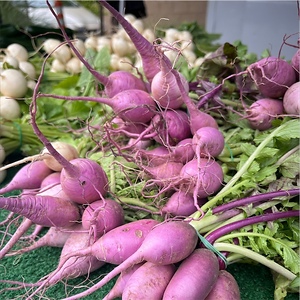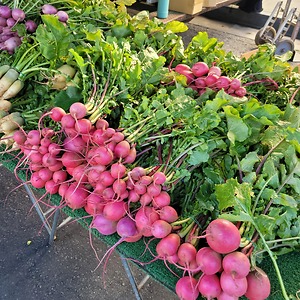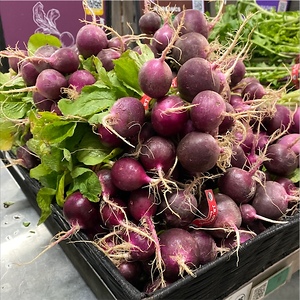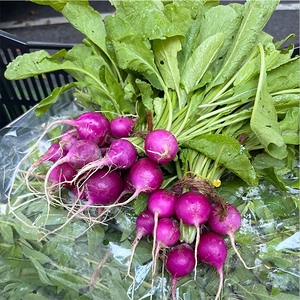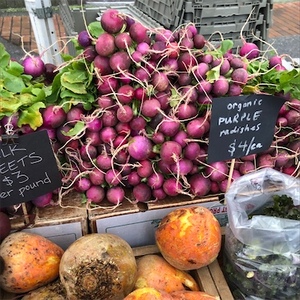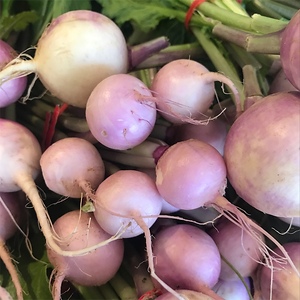


Purple Plum Radish
Estimated Inventory, 24 ct : 0
Description/Taste
Purple Plum radishes are small in size, averaging 2 to 5 centimeters in diameter, and have a round, oval, to teardrop shape with a single, elongated taproot. The radish’s skin is smooth, taut, and thin, showcasing vibrant hues of violet, burgundy, to purple-pink. Underneath the surface, the translucent white flesh is dense, aqueous, and firm with a crisp and crunchy, snap-like consistency. Purple Plum radishes have a semi-sweet, subtly peppery, and mild flavor when raw, and the variety is known for not becoming pithy, even with extensive cultivation. Purple Plum radishes are also generally milder than other table radish cultivars. Once cooked, the radish’s flesh will soften and develop a mellow, neutral, and savory-sweet flavor. In addition to the roots, Purple Plum radish leaves are edible and have a pungent, green, and grassy taste. The soft and crisp leaves are attached to the roots through fibrous green stems and have a ruffled, textured surface with prominent veining and serrated edges.
Seasons/Availability
Purple Plum radishes are available in the spring through early winter.
Current Facts
Purple Plum radishes, botanically classified as Raphanus sativus, are a brightly colored variety belonging to the Brassicaceae family. The mild radishes are a fast-growing, early-season cultivar that matures in 25 to 30 days and was developed in the Pacific Northwest of the United States. Purple Plum radishes are valued among gardeners and farmers for their hardy nature, neutral flavoring, and crisp, non-pithy flesh. The variety received its vibrant skin coloring from natural pigmentations and was created through traditional breeding techniques. In American markets, Purple Plum radishes are sometimes included in mixed radish bundles to add color and mild flavor. They are also known as a spring or table radish, a term used for small radishes grown for everyday consumption, favored for their compact size and sweet, subtly peppery taste.
Nutritional Value
Purple Plum radishes are a source of vitamin C to strengthen the immune system while reducing inflammation, potassium to balance fluid levels within the body, and fiber to regulate the digestive tract. The roots also provide magnesium to regulate nerve and muscle functioning, vitamin A to assist in faster wound healing, calcium and phosphorus to protect bones and teeth, and lower amounts of copper, iron, and folate. Beyond vitamins and minerals, the purple flesh provides anthocyanins, colored pigments with antioxidant-like properties to protect the cells against damage caused by free radicals.
Applications
Purple Plum radishes have a mild, sweet, and subtly peppery flavor suited for raw and cooked preparations. The radishes can be consumed straight out of hand or sliced and served with dips and displayed on charcuterie boards. The radishes can also be chopped and tossed into salads, incorporated into coleslaws, or grated and tossed with dressings, oils, or herbs as a side dish. The brightly colored skin adds visual appeal to sandwiches, sliced and layered on buttered bread, or used as a crunchy topping over tacos. In addition to fresh preparations, Purple Plum radishes can be cooked into omelets, roasted as a savory side, mixed into casseroles, or baked with other root vegetables. The roots can also be sliced into chips and fried, chopped and tossed into curries, soups, and stews, sliced and roasted for a caramelized flavor, or stir-fried with vegetables as a main dish. Beyond the roots, Purple Plum radish leaves are edible and can be tossed into salads, sauteed as a side, or simmered into soups. Purple Plum radishes pair well with herbs such as thyme, rosemary, parsley, and sage, Dijon mustard, honey, balsamic vinegar, and other root vegetables, including parsnips, carrots, and turnips. Whole, uncut Purple Plum radishes will keep 1 to 2 weeks when wrapped in newspaper or plastic and stored in the refrigerator. Once cooked, the radish pieces will keep for 3 to 7 days, and the leaves will keep up to 3 days in the fridge. Purple Plum radishes can also be blanched and frozen for extended use for one month or pickled as a tangy condiment.
Ethnic/Cultural Info
The Alf Christianson Seed Company was created by Alfred Christianson in 1926 in Mount Vernon, Washington. Alf Christianson previously worked at the Charles H. Lily Seed Company in Seattle and City Grain and Seed of Mount Vernon before establishing his own company growing and selling cabbage seeds. The Alf Christianson Seed Company continued to expand its seed line to other home garden vegetables, such as radishes, carrots, and beets and distributed their seeds throughout Washington. Purple Plum radishes were developed in 1985, and throughout the company’s history, Alfred Christianson’s family also helped in the business, including his wife, Lucy Christianson. Lucy maintained the company’s bookkeeping and was also a horticulturist, taking classes, gardening, and driving through the company’s fields on an ATV. Alfred’s son, Mark Christianson, was also a nurseryman and lived in Washington, actively serving as a board member for several agricultural associations. The Alf Christianson Seed Company specialized in seed breeding and distribution for many years until the Sakata Seed Corporation acquired it in 2002. Even after its acquisition, several of the company’s seed releases are still grown through specialty farms and in home gardens, including Purple Plum radishes.
Geography/History
Purple Plum radishes were developed and released by the Alf Christianson Seed Company in 1985 in Mount Vernon, Washington. The radishes were selected as an improved cultivar for their heat tolerance, low-bolting, fast-growing nature, and mild flavor. Purple Plum radishes were initially released in a seed catalog sold to growers throughout the Pacific Northwest. The radishes were accepted among home gardeners as a favorable spring or table radish. Besides records of its introduction, much is unknown regarding Purple plum radishes. Today the variety is offered through online seed catalogs in the United States and is mainly sold as a specialty cultivar offered by select growers and retailers. The variety is also cultivated in home gardens for personal use.
Recipe Ideas
Recipes that include Purple Plum Radish. One
| Tigers and Strawberries |
|
Stir Fried Tofu, Bok Choy, Carrots and Radishes |



